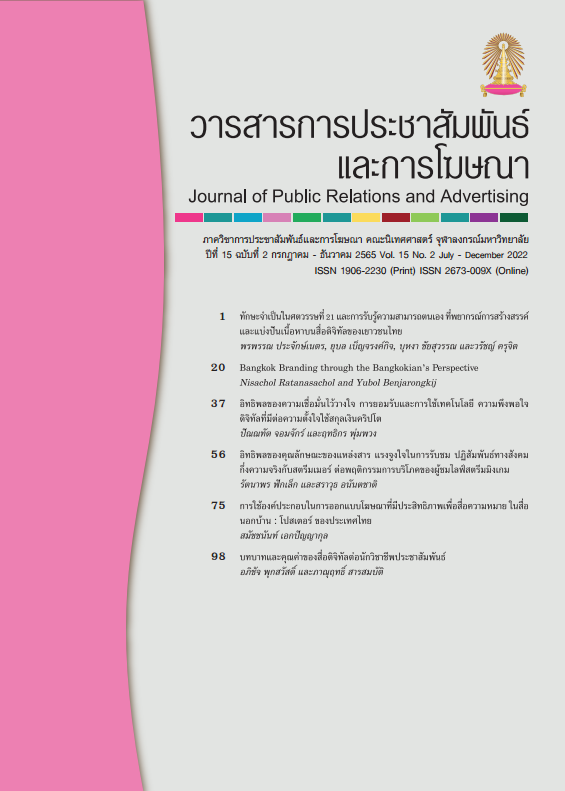Influences of Source Characteristic, Motivation to Watch, and Parasocial Relationship with Game Streamers on Livestreaming Game Viewers' Consuming Behavior
Main Article Content
Abstract
This survey study is aimed to investigate: 1) source characteristics, motivation to watch, parasocial relationships and live-streaming game viewers’ consuming behavior, and 2) their influences on viewers’ consuming behavior. Online questionnaires were used to collect data from 1) 201 participants, aged 18 – 35 years old, having followed James Room Facebook pages during the past three months, and having watched live-streaming game at least four times a month, and 2) 300 participants, aged 18 – 35 years old, having followed Heartrocker Facebook pages during the past three months, and having watched live-streaming game at least four times a month. The findings showed that source characteristics, motivation to watch, parasocial relationship and viewers’ consuming behavior for James Room and Heartrocker pages were significantly different. Parasocial relationships played the most important factor on viewers’ sense of community, subscription intention, donation intention and purchase intention for both James Room and Heartrocker pages.
Article Details
References
Bangkokbiznews. (2564). 'เกม-อีสปอร์ต' คลื่นลูกใหม่ ยุค Attention Economy. วันที่เข้าถึงข้อมูล 10 กุมภาพันธ์ 2564, แหล่งที่มา https://www.bangkokbiznews.com/news /detail/862125
Thansettakij. (2563). ภาพรวมตลาดเกมปี 2563. วันที่เข้าถึงข้อมูล 11 กุมภาพันธ์ 2564, แหล่งที่มา https://www.thansettakij.com/infographic/928
Urguy. (2563). จิตวิทยาว่าด้วยเรื่อง “ทำไมเราจึงรัก Heart rocker.” วันที่เข้าถึงข้อมูล 21 มิถุนายน 2564, แหล่งที่มา https://gamerguy.in.th/why-we-love-heartrocker/
Alexander, P. S., Loes, J., & Maegan, V. (2020). Celebrity vs. influencer endorsements in advertising: The role of identification, credibility, and product-endorser fit. International Journal of Advertising, 39(2), 258-281.
Belch, G. E., & Belch, M. A. (2004). Advertising and promotion: An integrated marketing communications perspective (6th ed.). Boston: McGraw-Hill.
Blight, M. G. (2016). Relationships to video game streamers: Examining gratifications, parasocial relationships, fandom, and community affiliation online. Retrieved December 15, 2020, from https://dc.uwm.edu/etd/1255
Casaló, A. L., Flavian, C., & Ibáñez, S. S. (2019). Antecedents of consumer intention to follow and recommend an Instagram account. Retrieved December 15, 2020, from https://www.researchgate.net/publication/336474621_antecedents_of_ consumer_intention_to_follow_and_recommend_an_instagram_account
Chung, S., & Cho, H. (2017). Fostering parasocial relationships with celebrities on social media: Implications for celebrity endorsement: Celebrity parasocial relationships on social media. Psychology & Marketing, 34, 481-495.
Cornan, S., Hess, A., & Justus, Z. (2006). Credibility in the global war in terrorism: Strategic principles and research agenda. Consortium for strategic communication. Phoenix, AZ: Arizona State University.
Dodds S., Hess A., & Rahman, N. (2019). Parasocial relationships and Instagram celebrities. Retrieved December 15, 2020, from http://proceedings.emac-online.org/pdfs/A2019-8411
Ekaterina, P., & Netta, G. (2017). 4 reasons people watch gaming content on YouTube. Retrieved February 10, 2021, from https://www.thinkwithgoogle.com/
Erdogan, B. Z., Baker, M. J., & Tagg, S. (2001). Selecting celebrity endorsers: The practitioner’s perspective. Journal of Advertising Research, 41(3), 39–48.
Gosling, V., & Crawford, G. (2011). Game scenes: Theorizing digital game audiences. Games and Culture - Game Cult, 6, 135-154.
Gros, D., Wanner, B., Hackenholt, A., Zawadzki, P., & Knautz, K. (2017). World of streaming. motivation and gratification on Twitch. Retrieved February 10, 2020, from https://https://www.researchgate.net/publication/317172067
Hawkins, D. I., & Mothersbaugh, D. L. (2010). Consumer behavior: Building marketing strategy (11th ed.). Boston: McGraw-Hill Irwin.
Hovland, C. I., Janis, I. L., & Kelley, H. H. (1953). Communication and persuasion: Psychological studies of opinion change. New Haven, CT: Yale University Press.
Hovland, C. I., & Janis, I. L. (Eds.). (1959). Personality and persuasibility. New Haven, CT: Yale University. Press.
King, R. & De la Hera, T. (2020). Fortnite streamers as influencers: A study on gamers’ perceptions. Computer Games Journal, 9, 1-20.
Labrecque, L. (2014). Fostering consumer–brand relationships in social media environments: The role of parasocial interaction. Journal of Interactive Marketing, 28(2), 134-148.
Liu, M.T., Liu, Y., & Zhang, L. L. (2019). Vlog and brand evaluations: The influence of parasocial interaction. Asia Pacific Journal of Marketing and Logistics, 31(2), 419-436.
McGuire, W. J. (1985). Attitudes and attitude change. In Aronson, E., & Lindzey, G. (Eds.), The handbook of social psychology (3rd ed., Vol. 2, pp. 233–346). New York, NY: Random House.
Ohanian, R. (1990). Construction and validation of a scale to measure celebrity endorsers' perceived expertise, trustworthiness, and attractiveness. Journal of Advertising, 19(3), 39–52.
Smith, K. M. (2011). The relationship between residential satisfaction, sense of community, sense of belonging and sense of place in a Western Australian urban planned community. Retrieved June 25, 2020, from https://www.semanticscholar.org/paper/The-relationship-between-residential-satisfaction%2CSmith/48fe190df562c3008ab6434def2fb62df3d6912b
Solomon, M. R. (2018). Consumer behavior: Buying, having, and being (12th ed.). Harlow, UK: Pearson.
We Are Social. (2020). Digital 2020: Global digital overview. Retrieved February 10, 2021, from https://wearesocial.com/digital-2020
Wohn, D., Freeman, G., & McLaughlin, C. (2018). Explaining viewers' emotional, instrumental, and financial support provision for live streamers. Retrieved December 15, 2020, from https://dl.acm.org/doi/10.1145 /3173574.3174048
Zhao, H., Su, C., & Hua, Z. (2016). Investigating continuance intention to follow a brand micro-blog: Perceived value and social identification. Information Development, 32(5), 1428–1441.


